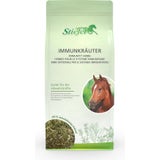Thrush in Horses
What is Thrush?
Thrush is the term used to describe putrefactive processes on the hoof and the adjacent tissue such as the frog, sole and ball of the hoof.
Possible Causes of Thrush
There are several possible causes of thrush. It can be observed that horses in open stables and unshoed horses are much less likely to develop thrush. This suggests that incorrect fitting and often closed fitting of orthopaedic irons can lead to thrush. But a lack of exercise also has a negative effect on the development of thrush.
Hygiene also plays an important role in the formation of thrush. If the stables/boxes are not properly and regularly mucked out, horses could end up spending long periods of time standing in their own waste. These faeces are a good breeding ground for bacteria and fungi that spread to the hoof. In addition, ammonia attacks the hoof and the horn. This can make an infection much easier. So you should pay attention to freshly littered, clean and dry boxes and general stall hygiene in order to better prevent thrush.
Another, not insignificant cause of thrush is the horse's metabolism because thrush can spread much better with a weakened immune system. The hoof is permeated with many immune cells, which ensure that no pathogens can penetrate deep into the hoof. With a strong immune system, bacteria and fungi have a worse chance of attaching themselves to the animal's hoof and multiplying there. Normally, the normal growth process of the hoof removes the bacteria and fungi and the germs remain on the surface of the hoof. However, if the immune system is weakened, hoof growth can also be restricted and the bacteria and fungi stay longer on the hoof surface so that they can colonize and multiply there. The blood flow to the hoof is also reduced due to a weakened immune system. This can allow infections to spread better on the hoof. The pathogens then penetrate deeper and deeper into the hoof and primarily attack the frog, whereupon the putrefactive process begins.
In severe cases, re-infection can occur when the hoof is cut out, as the pathogens are too deep in the hoof and the cause has not been combated. The hoof can become softer and more brittle and the quality of the horn deteriorates. A small vicious circle begins.

Hoof horn, which only grows back very slowly, cannot be cut out regularly, otherwise the horse would be in pain if the hoof is cut “too short”. Similar to a too short, sensitive fingernail. Due to the longer interval between the hoof care by the blacksmith, the affected areas with thrush are cut out less and less and the pathogens can multiply even further and penetrate deeper into the hoof. The quality of the hoof or the hoof horn decreases more and more.
In severe cases, the quality of the horn can be so bad that it can also cause ulcers. Most of the time, hoof ulcers are very painful, so that the horses hardly move. The problem: the lack of exercise further reduces the blood flow to the hoof. In addition, the ulcer is another "weak point" in the hoof, which can be more easily attacked by bacteria and fungi.
The metabolism naturally also includes the detoxification processes. If the detoxification processes are disturbed by, for example, incorrect feeding, lack of exercise, stress or the administration of medication, degradation products / waste materials can no longer be removed from the body as well. These waste materials can also damage the hoof, so thrush can occur due to a lack of detoxification process.
Incidentally, this is one of the main causes of thrush in many horses!
The causes of thrush can therefore be very diverse and, above all, complex.
But how do I know if my horse has thrush?
It is actually quite easy to spot thrush. The horny substance and also the smell of the hoof/horn change. The greasy, putrid hoof substance, which is particularly noticeable in the area of the frog, is noticeable. Most of the time the horn even turns black and the substance of the horn changes from hard to brittle-soft. There is also a foul-smelling, putrid smell. This smell is mostly noticed when scratching out the hooves or putting on the bell-shaped boots - always when we come very close to the horse's hoof, but especially when we lift the hoof up. In worse cases, the beam becomes significantly thinner and virtually dissolves. In most cases, adjacent areas such as the balls of the feet are also affected. (Painful) crusty areas can develop on the pads. Sometimes the affected leg is also swollen and the horse shows signs of pain when touching the hoof, ball of the foot or leg.
ATTENTION: Since thrush is difficult to distinguish from hoof cancer in some cases, you should consult a veterinarian if the symptoms mentioned occur! Sometimes both diseases occur at the same time.
Latest reviews
-
 5.0 (7)
5.0 (7)Stiefel Linseed Granules, 5 kg
- Ready-to-feed linseed cake
- High mucilage content
- Reduced fat content due to cold pressing
£17.80 (£3.56 / kg)Delivery by January 07
-
 4.8 (10)
4.8 (10)Stiefel Kräuterlix Horse Lick, 1 kg
- Lick stone with bronchial herbs
- A tasty reward
- With attached cord to tie it up
£13.33 (£13.33 / kg)Delivery by January 07
-
 5.0 (7)
5.0 (7)Stiefel Immunity Herbs , 1 kg
New!- 100% natural herbal mixture
- Immunity herbs
- Good for the body's defences
£22.27 (£22.27 / kg)Delivery by January 07
-
 4.8 (6)
4.8 (6)Stiefel Immunity Herbal Liquid, 1 l
Bestseller- To support the immune system
- Made of 100% natural herbs
- No added sugar
£15.12 (£15.12 / l)Delivery by January 07
-
Great Britain: Free standard delivery from £79.90
-
Free
returns Secure payments
with SSL encryption technology

